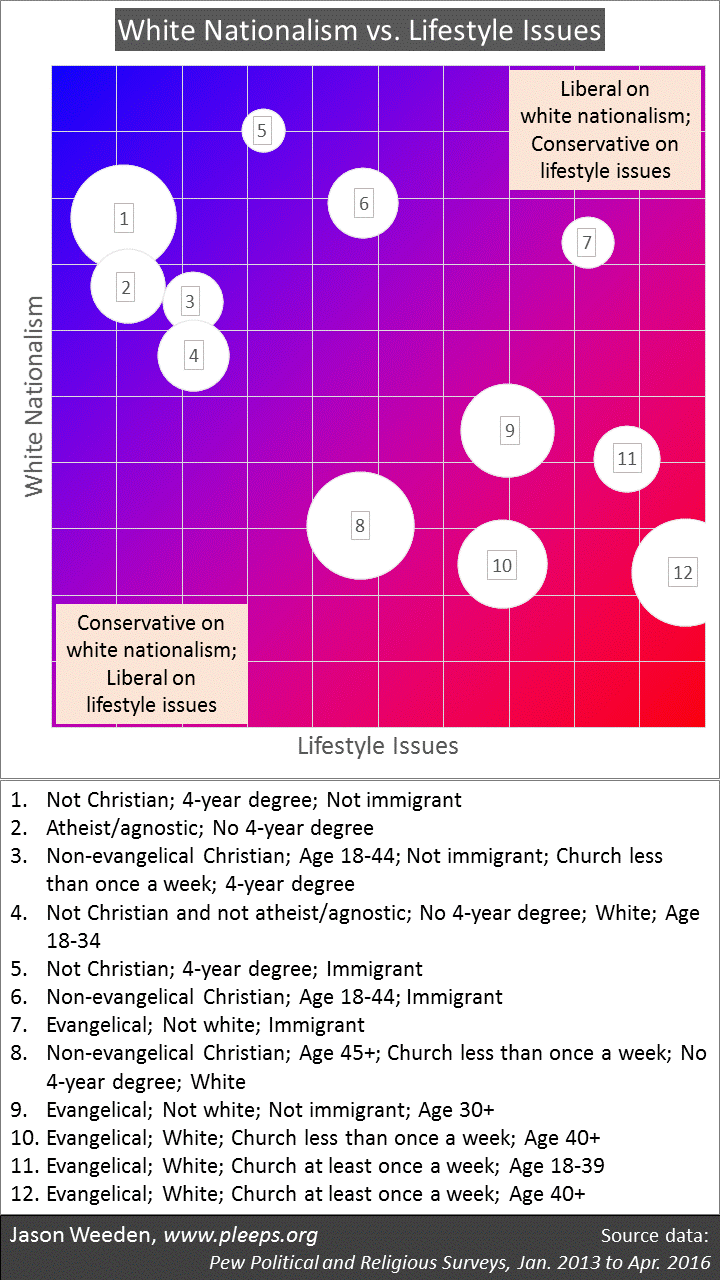Often you’ll see political researchers and commentators divide the issue landscape into “economic” issues on the one hand and “social” or “cultural” issues on the other. However, this isn’t a great way to think about things, mainly because there’s only a loose relationship among many of the social/cultural issues.
The primary divide within social/cultural issues is between those that relate strongly to race and those that relate strongly to church attendance. Examples of the former are items such as affirmative action, immigration, the death penalty, and gun control. Examples of the latter are items such as abortion, same-sex marriage, marijuana legalization, as well as views on premarital sex, having kids outside of marriage, and pornography.
These are all issues one typically has in mind when talking about social/cultural issues, but in fact racial items are often not very strongly correlated with lifestyle items. There are plenty of folks with liberal racial views but conservative lifestyle views, and vice versa. Further, various racial issues actually correlate pretty strongly with opinions on redistributive economics whereas lifestyle issues typically have more modest correlations with economic issues.
For the analysis in this post, I combined a bunch of racial items into a single white nationalism measure (it’s the same one I used in a previous post on white nationalism vs. economic conservatism, which is mostly about immigration, but also has items on blacks, guns, and Middle Eastern conflicts) and also combined a bunch of church-correlated items into a single lifestyle issues measure (these were items on homosexuality, abortion, marijuana legalization, and having children outside of marriage; I give further details at the bottom of this post). I then started splitting the sample based on the biggest demographic predictors of these two measures, ending up with over 20 distinct demographic groups.
The chart below shows the 12 groups with the most liberal and most conservative averages on white nationalism and/or lifestyle issues. Some are pretty conservative on both—mainly groups with white evangelicals who are older and/or regularly churchgoing (i.e., those in the lower-right red corner). Some groups are pretty liberal on both—mainly groups that have some combination of being less religious, more educated, and/or younger (i.e., those in the upper-left blue corner).
 (Note: “Evangelical” means non-Catholic Christians who either self-identify as “born again or evangelical” or are Mormon. “White” means non-Hispanic white.)
(Note: “Evangelical” means non-Catholic Christians who either self-identify as “born again or evangelical” or are Mormon. “White” means non-Hispanic white.)
But there are also groups with pretty substantial gaps between their white nationalism positions and their lifestyle issues positions. The key one is group 7 (i.e., evangelicals who are non-white immigrants). On average, they’re rather liberal on white nationalism but also rather conservative on lifestyle issues. Turns out that not that many immigrants think immigrants are threatening, and not that many self-described evangelicals are pro-gay, pro-choice, and so on. Other groups that skew in this direction include group 6 (i.e., immigrants who are younger non-evangelical Christians), who tend to be liberal on white nationalism but centrist on lifestyle issues, and group 11 (i.e., white evangelicals who are churchgoing and young), who tend to be conservative on lifestyle issues but just right of center on white nationalism.
On the other side are groups that are more conservative on white nationalism than on lifestyle issues. These include group 8 (i.e., white non-evangelical Christians who are younger, don’t attend church regularly, and don’t have 4-year degrees), who tend to be pretty conservative on white nationalism but centrist on lifestyle issues. It also includes groups 2 (i.e., atheists and agnostics without 4-year degrees) and 4 (i.e., other non-Christians without 4-year degrees who are white and young), both containing folks who are on average very liberal on lifestyle issues but not as liberal on white nationalism.
Taking a broader view, here’s what we’re looking at. With all political issues these days, there are pervasive themes and varying domain-specific themes. The pervasive themes are the liberalism of non-Christians (particularly when college-educated) and the conservatism of white evangelicals (particularly when not poor). These patterns will show up in pretty much any widely debated partisan issue these days.
But there are also domain-specific themes. On economic issues, wealthier whites are more conservative and poorer minorities are more liberal. On white nationalism, low-education whites are more conservative and the various targets of white nationalism—immigrants, blacks, Muslims, and so on—are more liberal (especially on issues specifically impacting themselves, e.g., blacks on racial issues, immigrants on immigration issues, etc.). On lifestyle issues, low-education churchgoers are more conservative and high-education secular folks are more liberal. Sometimes these domain-specific themes create interesting ideological divergence.
Some details on sample and measures
I’m working off my recently updated aggregate Pew file that I described in a prior post. The white nationalism measure is the same one I described in that post, combining 58 individual survey questions (mostly on immigration, but also items on race, gun control, and military/Middle East/Muslims).
The lifestyle measure combines 27 items, of which over 74,000 respondents were asked at least one. The main items include: whether homosexuality should be accepted or discouraged, whether same-sex marriage should be allowed, whether abortion should be legal or illegal in all or most cases, whether more people having kids without getting married is a change for the better or the worse, whether society is better off if people make marriage and having kids a priority, whether pot should be legal, and so on.
OK, so I’ve compared white nationalism with economic issues in my prior post and white nationalism with lifestyle issues in this post. I’ve got one more to go—comparing economic issues with lifestyle issues.
